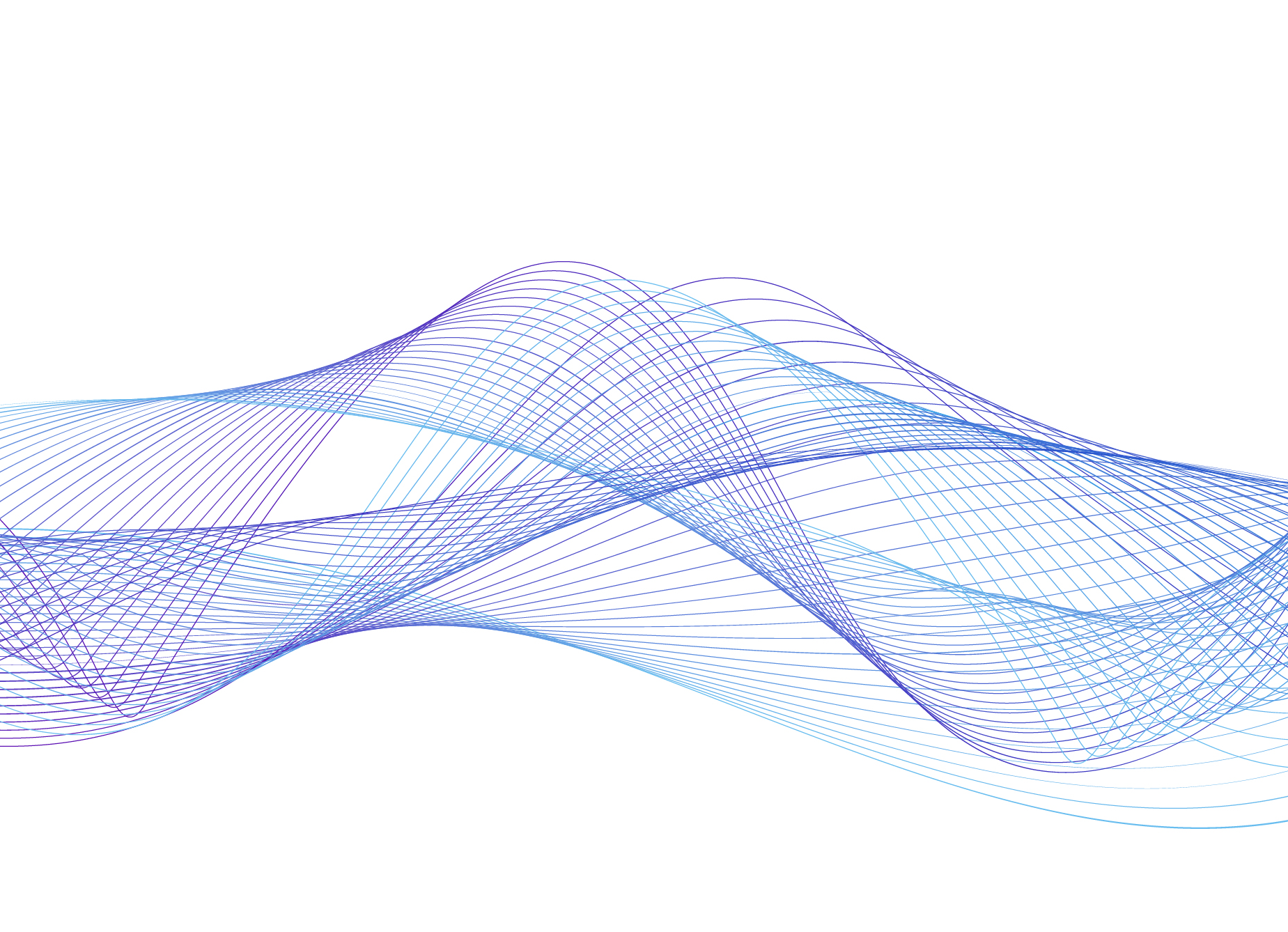There’s a fair chance you’ve heard of white noise before. You may even have already read about how it can help you sleep, think, and concentrate better, by hiding unwanted sounds around you. And if you got ever so slightly curious about white noise, then you’ve likely heard of pink noise too. Have you been searching for ways to improve speech privacy and reduce noisy distractions in your office space? Then you may even already know about sound masking.
In fact, many people use the terms white noise, pink noise, and sound masking interchangeably. And while referring to how such special sounds do a great job at drowning out undesirable sensory stimuli, it’s easy to assume that all colored noises, white/pink/brown noise generators, sound machines, and sound masking systems are one and the same. However, they are not the same at all.
White Noise: Why Is It Called That?
Why is it called White Noise anyway? You may have already learnt that White Light is the combination of all the different colors in the color spectrum, right? Similarly, white noise is a combination of all of the different frequencies of sound – such as all of the imaginable tones that a human can hear, played together at the same time. White light is us seeing all colors at the same time. White noise is us hearing all frequencies at the same time.
And the same goes for pink noise, brown noise, and all other colored noises too. It also applies to sound masking, a specially engineered noise used to even out the soundscape of uncomfortably quiet offices and improve the acoustic privacy of employees. So whether you’re talking about white noise, pink noise, brown noise, or sound masking, they can all be referred to as broadband noises, noises whose energy is distributed across the entire audible range of frequencies – simply put, random, continuous noises that are simultaneously low, mid and high-pitched, but in varying proportions depending on the noise color or type you’re dealing with.
In fact, many familiar sounds resemble white and pink noise, such as the sound of heavy rain, waterfalls, wind, ventilation systems – even the sound of a big crowd cheering in a stadium. Meanwhile, the best approximation to white noise remains the static sound you hear between radio stations on the FM band, or the “snow” you get on a television with no signal. That’s right, to most people, white noise sounds just like a broken TV set.
Unsurprisingly, most people imagine white noise just like this:

And indeed, white noise sounds just like this:
Enjoy this 1 minute of pure white noise. It does sound a bit like a broken TV, doesn't it?
White Noise, Pink Noise, and Sound Masking Are Different Kinds of Broadband Noises
Indeed, white noise, pink noise, and sound masking are all fundamentally broadband noises, but that’s pretty much all they really have in common. Think of white grapefruit, pink grapefruit, and oranges. They’re all fruits and they’re all citrus fruits at that, white and pink grapefruit being closely related varieties of the same citrus fruit. All these fruits can help you live a better life. They all contain lots of vitamin C. Do they all taste the same? No. Do you enjoy them all equally? Probably not.
Just like broadband noises, citrus fruits come in an array of colors and a full range of flavors, from intense and tart to mild and sweet. For instance, pink colored grapefruit is noticeably sweeter (and possibly easier to enjoy?) than its ancestor, white grapefruit. Meanwhile, pink noise, which is essentially a filtered byproduct of white noise, is also generally considered “sweeter”, less harsh sounding, less “in your face” than its immediate ancestor, white noise – the true original. And what about oranges? You mean, what about sound masking, right?
Even though oranges and grapefruit are somewhat related, they are different in many ways. For one thing, oranges don’t descend from grapefruit, nor are they a white-pink grapefruit hybrid. Similarly, it’d be incorrect to say that sound masking derivates from white noise. It’d also be incorrect to assume that sound masking is some sort of specially engineered mixture of white and pink noise.
But sound masking is a specially engineered noise indeed. And it’s intended to serve a well-defined purpose: to effectively mask out unwanted sounds that hamper both employee productivity and sonic privacy in typical office settings, loud conversations and mundane distractions in particular, without becoming a source of discomfort in itself. To quietly fight off a wide array of sonic stimuli while continuously maintaining a soundscape that’s pleasant for each and every office occupant, introverts and extroverts alike, seems like an awful lot to ask from something that’s fundamentally noise itself, don’t you think? But that’s exactly what good sound masking is set to achieve.
Ok so now how the heck does this relate to grapefruit and oranges?
Could it be said that oranges are superior to grapefruit, the white like the pink? Not really. But consider this: Aiming to achieve one thing as smoothly as possible, which is serving breakfast in this case, could it be said that oranges are a “safer choice” than grapefruit when the goal is to accomodate as many different people as possible, dealing with an endless range of individual preferences and needs? Maybe… Would you rather drink a tall glass of pure white grapefruit, pink grapefruit or orange juice? It’s a question of personal taste really. But if you were to serve breakfast to a group of say 50 people you don’t know anything about, which citrus juice would you have them drink?
White noise, pink noise, sound masking. All these broadband noises can, to some extent, be used to drown out sounds we do not wish to hear. It’s actually one of the reasons white noise can help certain people sleep better, by keeping all sorts of nightly disruptive sounds at bay. But unlike white and pink noise, sound masking was specifically thought and developed to achieve just that in various workplace settings, open plan offices in particular, where things are never just about a single individual. And while a good-quality white noise machine can perhaps be a “life changer” in one’s bedroom, we guarantee you that it’ll be quite a letdown in your typical office space, regardless of how busy or quiet it gets.
White Noise VS Pink Noise: A Subtle Yet Significant Difference
Now if you ask an acoustician to explain the fundamental difference between white noise and pink noise, the answer will be quite brief, but slightly more technical than some odd analogy with citrus fruits: White Noise contains the same total amount of energy within each frequency. Pink Noise contains the same total amount of energy within each octave. A subtle yet significant difference nonetheless. The devil is in the details some say…
Both white and pink noise are considered broadband noises. Both of them are made of all frequencies that are audible to humans, so all frequencies anywhere between 20 and 20000 hertz. But the way their signal power is distributed among all frequencies radically differs, and you can see that using a power analyzer or just by looking at the simple sound spectrum graphs provided below.
White Noise Spectrum Explained
First off, the spectra of white and pink noise can be a source of confusion. The confusion is primarily due to the fact that the graphical representation of white and pink noise will be completely different depending on the the type of analyzer being used. For instance, viewed in a spectrogram set in narrow bands, white noise looks just like the image below. Notice how flat the spectrum is? That’s because all frequency bands (ascending left to right on the x-axis) have more or less the same energy level.
White Noise Spectrum Viewed in Narrow Bands
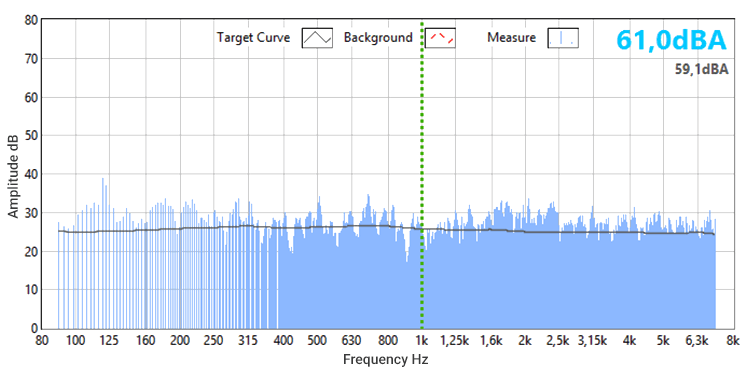
And now here’s where things get a little confusing…
The very same white noise signal, but viewed in third-octave bands instead of in narrow bands, looks completely different from the image in figure 1 above. Notice how the spectrum isn’t flat anymore but sloping upward as we go from lower to higher frequencies?
White Noise Spectrum Viewed in Third-Octave Bands
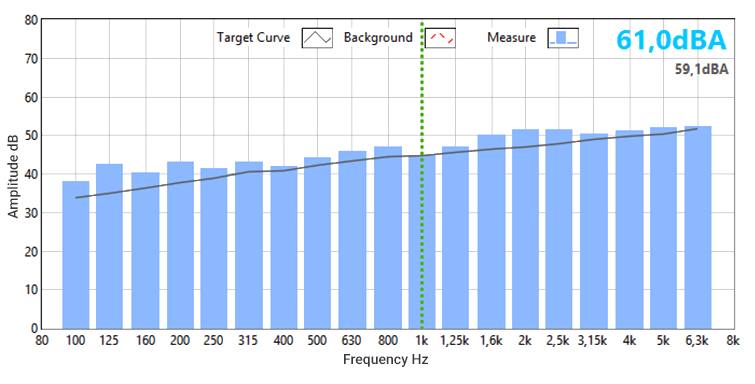
Indeed, when analysing white noise in third-octave bands, the higher the frequencies the more powerful they get. But isn’t white noise supposed to be equal energy at each single frequency (same energy at 100 Hz, 200 Hz, 1000 Hz, 5000 Hz etc.)? What the heck kind of sorcery is this you may rightfully ask? Well, white noise IS equal energy per frequency, but ISN’T equal energy per octave. And in order to fully understand this subtle, yet significant difference, you should know what octaves are.
What Are Octaves?
Octaves are groups of frequencies that help quantify how the human hearing system picks up different frequencies. Each octave represents the overall level of sound energy over a specific frequency range. Now here’s the thing: Octave bands at higher frequencies regroup a broader frequency range than octave bands at lower frequencies. That’s because at lower frequencies, the human ear can easily distinguish between each frequency, but starts having more and more difficulty distinguishing between them as they get higher, even high frequencies that are far from one another.
Therefore, at lower frequencies, the octave bands are narrower, and at higher frequencies, the octave bands are wider. To help you grasp this concept better, the table below shows the typical octave bands used in acoustics and the frequency range contained in each band. The numbers make it very clear: the 8000 hz octave band regroups a lot more frequencies than the 63 Hz octave band.
Octave Bands and the Frequencies They Regroup
| Octave Band Center Frequency (Hz) | Lower Frequency | Higher Frequency | Octave Range (# of frequencies) |
|---|---|---|---|
| 63 | 44 | 88 | 44 |
| 125 | 88 | 177 | 89 |
| 250 | 177 | 355 | 178 |
| 500 | 355 | 710 | 355 |
| 1000 | 710 | 1420 | 710 |
| 2000 | 1420 | 2840 | 1420 |
| 4000 | 2840 | 5680 | 2840 |
| 8000 | 5680 | 11360 | 5680 |
Mathematically speaking, an octave refers to the interval between one frequency and its double or its half. For instance, as shown in the table above, there is one octave band between frequencies 88 Hz and 177 Hz, that’s the 125 Hz band, and there’s another octave band between 177 Hz and 355 Hz, that’s the 250 Hz band. The 250 Hz octave band contains 178 invididual frequencies while the 125 Hz octave band only contains 89. The 250 Hz octave band is therefore wider than the 125 Hz band.
Octaves Are the Logarithmic Units for Frequency
Meanwhile, looking back at the figure 2 above, you may wonder how come the octave bands all have the same exact width even though we’ve just explained how it wasn’t the case… And you’re right. Octave bands are not equally spaced. But in order to simplify things a little, octaves are often displayed just like in the spectrum in figure 2, so that each band’s center frequencies are linearly spaced. You may call this the octave format, but we prefer to refer to it as octave bands viewed on a logarithmic scale.
Such scale makes the octave bands appear equally spaced in frequency even though it ain’t technically so, linearly speaking. Ok, so what are third-octave bands then? C’mon, seriously!?A third-octave band is one octave band split into three equal parts, thus providing acousticians with a more detailed view of noise content. It’s simply a three times more precise way of looking at sound. Because precision is everything in acoustical engineering.
The Higher the Frequency, the Louder We Hear Noise
So there you have it: to us humans, white noise sounds much brighter and harsher than what you’d expect from its relatively flat frequency spectrum. The reason for this is that our auditory system senses frequencies on a logarithmic scale (e.g. in octaves) rather than on a linear scale (i.e. in narrow bands). In other words, we “hear higher frequencies louder” than lower frequencies packing the same exact amount of energy. So on a logarithmic scale, from a human ear’s perspective, white noise does in fact pack more energy in the higher octave bands, hence its rather bright, hissy sound. More precisely, in figure 2 above, white noise gains 3 decibels per octave as we move towards higher frequencies.
What Is Pink Noise?
What happens if you take white noise and shave off some of its higher frequencies? In other words, what if you take white noise’s logarithmic spectrum, as shown earlier in figure 2, and make its slighly upward slope go perfectly straight instead? You get equal height octave bands and equal energy through and through, and—remember the acoustician’s definition of pink noise? Pink noise is equal energy per octave. Flattening white noise’s spectrum turned it into pink noise, which you’ll probably find a little less abrasive-sounding given how its higher frequencies are weaker, quieter. And why is it called pink noise instead of, say, white noise with weaker high frequencies? Simply because tweaking the power spectrum of visible light in a similar fashion makes the light appear pink instead of white. Once again, the name is nothing but a loose analogy to the colors of light.
Pink Noise Spectrum Viewed in Third-Octave Bands
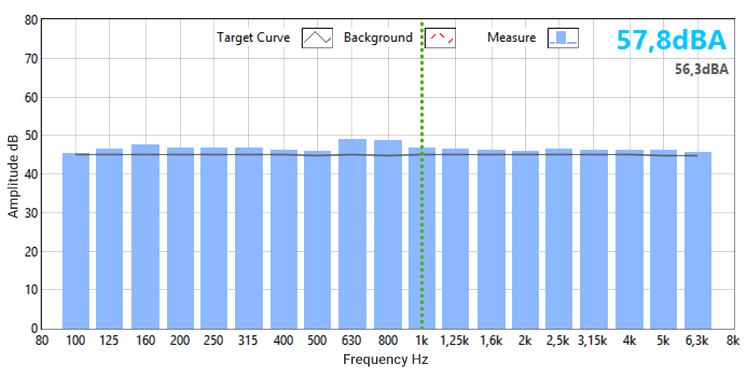
Now remember earlier in figure 1 how the white noise spectrum looked like a flat straight line when viewed in narrow bands on a linear scale? Based on what you know about pink noise, and how its energy distribution differs from white noise, how would you expect its spectrum to look like when viewed in narrow bands instead of third-octaves?
Keeping in mind what you know about octaves and how they work: if white noise has equal power per hertz throughout all frequencies and shows a positive slope when viewed in octave mode, then pink noise, which has equal power per octave throughout all frequencies, will logically show a negative slope when viewed in narrow bands, right? And there you go:
Pink Noise Spectrum Viewed in Narrow Bands

If you really like pink, you may prefer imagining pink noise just like this:

And how does pink noise sound? Just like this:
Pink noise sounds a bit like rain. Here's the real sound of rain to help you compare:
And here's the same white noise sample used earlier. Can you hear the difference with pink noise?
Sound Masking Is Neither White Noise nor Pink Noise, Although Pink Noise Is Closer to It Than Anything Else
One of the things that keep us up at night is how sound masking, which we use to improve employee concentration and acoustic privacy in office environments, remains all too often confused with white noise… and pink noise for that matter! Still, just looking at a typical sound masking spectrum the same way we’d look at white noise, in third-octave bands on a logarithmic scale, should be more than enough to make a strong case in point: they are two completely different things.
Graphically speaking, sound masking is practically the total opposite of white noise. Indeed, as we go from lower to higher frequencies, the white noise signal gains 3 decibels per octave while the typical sound masking signal loses 3 decibels per octave. Furthermore, unlike white noise, sound masking is everything but a straight, rather bumpy slope. In the figure below, notice how the sound masking spectrum gently curves down, almost without any noticeable increment?
Sound Masking Spectrum Viewed in Third-Octave Bands
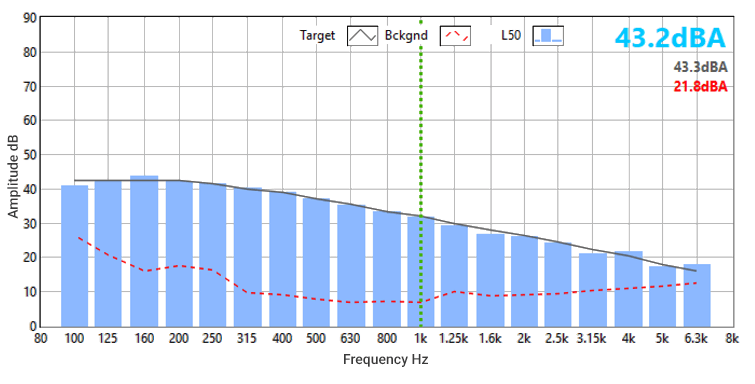
Graphical Representation of White Noise, Pink Noise, and Sound Masking Played at the Same Volume (45 dBA) Typically Used for Office Sound Masking Applications
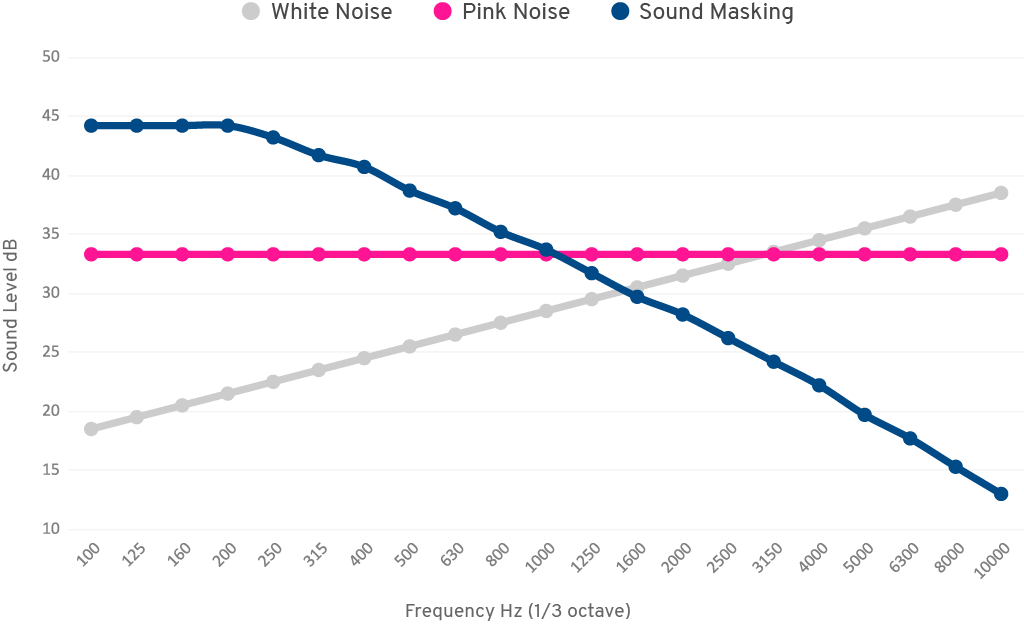
My Sound Masking Spectrum is Better Than Yours
When the goal is to improve an office’s sonic landscape while promoting optimal employee concentration and auditory privacy, sound masking’s gently curved-down spectrum is where the magic’s at. The sound masking spectrum is everything really. And of course, every major sound masking system manufacturer out there, namely Biamp’s Cambridge, AtlasIED, Lencore, and Logison, firmly believe that their sound masking spectrum is the Best in the West – the real McCoy. We can’t blame them though, for we at Soft dB believe the exact same thing… what’cha gonna do about it?
Often though, the right sound masking spectrum is specified by an acoustical consultant or a third-party expert. This way, the sound masking system manufacturer’s own bias is left out of the equation. This also helps ensure a certain degree of transparency in the decision-making process, while keeping primitive, obsolete sound masking technologies away from consideration. Indeed, science should always speak louder than marketing. As acousticians ourselves, we trust studies, not hypes.
And sound masking is a widely studied topic. So much in fact that it’d take one hell of a cheeky sales rep to try and fit the slightest white lie in there. For instance, the National Research Council of Canada (NRC) has conducted intensive studies and presented the ideal sound masking spectrum based on architectural and human factors that just can’t be ignored.
Anyway, whichever sound masking spectrum you ultimately choose to trust, making sure that what comes out of the sound masking loudspeakers above your head is gentle, subtle, pleasant, and, more importantly, effective at masking off human speech, is all about fine tuning that spectrum. It’s all about adapting that sound masking spectrum to the existing background noise levels and acoustical response of individual zones within the office. And we accomplish this by carefully adding and withdrawing sound at just the relevant frequencies, in just the right amount.
As a result, we obtain a smooth, perfectly tailored sound spectrum whose signal effectively drowns out critical frequencies of human speech – because conversations among colleagues remains the greatest source of distraction and confidentiality issues in most open office settings – all without adding unnecessary noise at higher frequencies. And since the sound masking signal continuously takes into account the existing ambient noise level in the room, it’s never too loud nor too quiet, regardless of the activity level underway. Are you into fine arts? The right sound masking spectrum is a work of art.
Sound Masking Is a Full-Featured System, Not a Standalone White or Pink Noise Emitting Machine
The ideal sound masking spectrum actually makes your office feel calmer and quieter. And unlike the sound emitted by white and pink noise machines, sound masking is unlocalizable and unnoticeable. It’s just there, perfectly diffuse and immersive, helping office occupants feel more comfortable acoustically. Part of this is because a sound masking system is everything but a single machine that outputs noise from one single location (e.g. your white noise machine sitting on your bedsite table).
Indeed, a sound masking system consists of many specially designed loudspeakers, coming in various shapes and sizes based on the office ceiling design, and strategically dispatched in small groups covering select distinct office zones. Now regardless of how many distinct zones there are, the entire sound masking system and its individual groups of speakers, most of which are hidden in the ceiling plenum space by the way, can be controlled from one single management interface. Convenient ain’t it?
Because just imagine how much of a pain in the butt it’d be to walk around a large office space, with dozens of independent speaker zones, and try to get each group, each loudspeaker to output a sound masking signal that’s just right for this one specific spot… Even us passionate acousticians wouldn’t have much patience for that! But of course, we gladly do it since, well, hey! it’s part of our job to fine tune your sound masking system, each individual group of speakers, so as to ensure that it becomes a true set-and-forget system for you. In fact, all you need to remember about your sound masking system is that it consists of many distinct groups of loudspeakers, each of which carefully tuned to output a masking signal that’s perfectly tailored to the select office zone it covers, and, perhaps the most important, coolest part: the whole thing is networked.
So is a sound masking system more expensive than your typical white or pink noise machine? Well, hmm… yeah! But at the same time, is a mass notification or paging system more expensive than Jane Doe making an important public announcement, standing in the middle of the office, microphone in hand, with a pole-mounted Mackie powered loudspeaker just beside her? You get the idea… Meanwhile, considering its actual return on investment, sound masking is NOT expensive.
What Is White or Pink Noise Good For?
Let’s begin with the less exciting stuff first, for a non-acoustician that is! In audio applications, both white and pink noise are often used as a reference tone to check frequency responses of sound systems. The concept is rather simple: White noise is played through the sound system and its output is verified using a linear spectrum (FFT) analyser.
If the system works the way it should, the frequency response will be flat when averaged over time, just like the pure white noise signal viewed earlier in figure 1. If pink noise is used instead of white noise, the system’s output is checked with a third-octave spectrum analyser, and the frequency response is also expected to be flat, just like the pink noise signal viewed in figure 4.
As we’ve seen earlier, pink noise is perfectly flat on a logarithmic scale. And since the human ear is also logarithmic by nature, pink noise is generally considered a better reflection of how humans perceive sound. For this reason, pink noise is the acoustician’s choice when simulating noise in real-life settings.
For example, when testing how good a wall is at blocking sound, we’ll blast pink noise on one side and measure the resulting logarithmic spectrum on the other side of the wall. It’s a standard method for measuring the acoustic performance in buildings and sound insulation properties of partitions.
Getting a Better Night’s Sleep
Can white noise and pink noise help you sleep better? As acousticians, we’ll limit ourselves here and simply respond that: as broadband noises containing all frequencies across the human hearing range, both white and pink noise can mask other sounds that occur naturally in your environment.
At night, such sounds, depending on where you live, will include some level of urban activity: honking cars, buses, trains, emergency vehicle sirens, barking dogs, the rumbling noise from downshifting trucks… Yet even in the quietest neighborhoods, there is rarely such thing as a dead silent night. Refrigerators make noise, sleeping partners may snore, and smartphones with their silent mode switched off may pop out bleepy notifications in the middle of the night.
And when you’re a light sleeper, a dripping faucet gets surprisingly loud at 3AM…
The thing is, your hearing doesn’t stop working while you’re asleep. So that leaves us with a vast array of disruptive sounds that can pull you out of dreams, if not prevent you from sleeping deeply enough to dream in the first place. So are white and pink noise machines (or mobile apps) a well proven solution to deliver sleep-friendly soundscapes to those having a hard time finding it night after night?
What do scientists and researchers have to say about all this?
There are indeed a couple well-documented studies supporting the idea that adding a little background noise, let it be white or pink, can help some people tune out sleep-disrupting creaks, squeaks, and bleeps. In a 2005 study entitled “The influence of white noise on sleep in subjects exposed to ICU noise”, researchers found that patients who slept with a white noise machine were less disturbed by the hospital sounds than those who slept without it.
Again, a 2012 study published in the Journal of Theoretical Biology, entitled “Pink noise: Effect on complexity synchronization of brain activity and sleep consolidation”, found that people experienced more stable, higher quality sleep when exposed to pink noise instead of pure silence. There are quite a few more studies which are really worth reading. At the end of the day, especially when it’s your health and wellness we’re talking about, you should always trust science before marketing hypes.
Can White Noise Help You Hear Better?
This one really caught our attention in late 2019. Exposed to a background of continuous white noise, hearing pure sounds becomes not less but even more precise. That’s right, led by Professor Dr. Tania Rinaldi Barkat from the Department of Biomedicine at the University of Basel, a research team was able to demonstrate that our brain’s ability to distinguish subtle tone differences noticeably improved when white noise was added to the background.
What’s more, their findings could ultimately be applied to the further development of cochlear implants. For people having suffered mild to severe hearing loss, this study published in Cell Reports makes for a rather promising future, doesn’t it?
Prior to this study, it was thought, logically so, that additional noise would make the hearing task even more difficult. However, the experiments showed that the brain’s ability to distinguish subtle tone differences became better when white noise was added to the background. Hearing was found to be superior under condition of white noise compared with a quiet environment.
So why would auditory acuity improve during noise? It is possible that total silence is an unnatural context and that the brain is simply optimized for more noisy environments.
White Noise Background Improves Tone Discrimination by Suppressing Cortical Tuning Curves
Noise Is Not the Same as Noise
What if Dr. Tania Rinaldi Barkat and her team were spot on? What if human beings weren’t fundamentally made for pitch silence? Sure enough, in our bedrooms just like in our offices, silence as we know it remains a golden commodity. But how much silence is too much silence? After all, isn’t it true, from a scientifical standpoint and our very own, that too much silence turns our brain greedy for noise? Doesn’t pin-drop silent make us overly alert for the slightest sound waiting to disrupt whatever activity we’re focused on, let it be sleeping or finishing some important report at work?
Let’s Conclude
By now, you should know quite a bit about white noise, pink noise, and sound masking. More importantly, you now know that they’re objectively and subjectively not the same at all. But each one has its purpose. And if you’re wondering how one of them, sound masking, can make your workspace a better place, we’ll gladly let you hear the difference for yourself.
How Is Soft dB Sound Masking Different?
Ok, so you already know that sound masking is neither white noise nor pink noise. Now what? Well… Not all sound masking systems are designed the same, that’s what. And if you’re wondering how we at Soft dB approach sound masking differently, read this short article about what makes our sound masking system unique.
